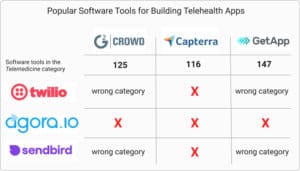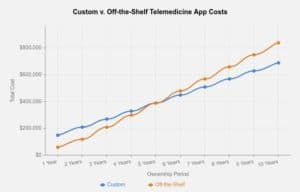Since the COVID-19 pandemic started, we’ve been receiving a lot of requests to build Teladoc clones. Yes, telemedicine — virtual doctor consultations via video calls — has indeed become a much sought after service.
As a result, many healthcare organizations face a dilemma: to purchase an off-the-shelf telehealth solution or build a custom platform.
In this blog, we’ll show you how these approaches stack up and explain to you how to build a custom telemedicine app like Teladoc in months, even though Teladoc has been around for almost a decade.
Table of Contents:
- Off-The-Shelf Telehealth App Market Overview
- Pros and Cons of Building vs. Getting Off-The-Shelf Telemedicine Apps
- Silver Bullet to Custom Telehealth App Development: Semi-Custom
- Killer Features of Semi-Custom Telehealth Apps
- How Topflight Makes the “Build” Path the Smart Money Play
- Time to Build Telehealth Platform
Off-The-Shelf Telehealth App Market Overview
If I were a CIO of a clinic looking to upgrade its services to telehealth standards, I know for sure it would be a nightmare. There are hundreds of telemedicine solutions on the market to choose from.
If I check the most popular software recommending sites like G2 or Capterra, I’m staring at well over a hundred telemedicine platforms. It’s a tough call to review all of them, let alone try their software to see how it fits our internal workflow — even for an experienced CIO.
At the same time, as someone who deals with telehealth and healthcare app development daily, as I skim through this lengthy list of telehealth products, I can’t see the tools that could help me build my own telemedicine product. Check it out:
Related Article: The Best Telehealth Apps
We’ll talk about how you can leverage those tools despite their absence from the major software catalogues below in section 3.
If you are not familiar with these telehealth enabling vendors, you’re stuck with choosing from other popular telemedicine options like Teladoc, Doxy.me, AmWell et al.
But before you rush to read user reviews to these platforms to see how they align with your work processes, let’s see if a custom-built telehealth platform is a better alternative.
Custom vs. Off-The-Shelf Telemedicine Apps
We often hear from our customers that they have to rely on several standalone applications to get meaningful telehealth going at their practice. So in most cases, this setup includes at least an EHR system integration and a telemedicine solution.
However, even though that approach was a no-brainer in the early COVID-19 days, providers do need a more straightforward experience now, with less jumping between different systems.
What will you gain or lose if you replace this combination of a standalone telemedicine app plus EHR with a unified off-the-shelf telemedicine product or build one from scratch?
Pricing
Let’s face it, an off-the-shelf telemedicine application will cost you less in the short-term perspective. However, subscription and transactional payments, which have become ubiquitous, will inevitably surpass the upfront investment you need to make when developing a custom telehealthcare solution.
Ready-made telehealth vendors may charge per minute, per provider, or offer a flat monthly fee. Regardless of their model, you’ll be paying every month, ratcheting the overall cost of the telemedicine system higher and higher. And this accumulative effect will start to add up when your practice begins to grow.
Here’s how we project the cost of ownership for custom vs. built telemedicine application can vary over time for a mid-sized practice with 20 clinicians, growing at a reasonable pace:
Remember that you also need to factor in support costs (for providers and patient assistance), plus your personnel will need to learn how to use the new shiny tool.
TLDR: the cost is more affordable for custom-developed telehealth apps, although the upfront investment is higher than an off-the-shelf solution, which starts to snowball over time.
Related: Understanding App Development Costs: Budgeting for your App
Features
In terms of functionality, both off-the-rack and custom-built telehealth apps can be quite similar. However, what happens in practice quite often is you get more features than you’re actually using with a ready solution (think of the 100’s of cable channels that you pay for but never watch!)
One other disadvantage of such one-size-fits-all telehealth solutions is that you depend on them to integrate with other medical systems you use on a daily basis. And if the vendor does not support integration with your particular EHR or practice management system, you’re out of luck.
Custom-built telemedicine apps are great in that respect because you get to choose what features will be there. Moreover, even if you’re not building all of them at once, you can ask your telemedicine developer to create an app architecture allowing further upgrades.
TLDR: you get the exact features you need and integrations with a custom solution, whereas a canned telemedicine platform would always come with something extra you don’t need and may miss a few things than you need.
Related: Everything you need to know to build your own telehealth solution
Branding
Of course, if you pay for a ready-made telehealth system, it will offer some sort of branding. One thing to keep in mind, though, is that you don’t decide how that would translate to your customers.
In other words, it may well be just a logo slapped onto an otherwise completely generalized interface, used by everybody else.
As you can imagine, your only limitation is imagination and the UX/UI acumen of the team that assists you when it comes to developing your own system.
TLDR: limited vs. unlimited branding opportunities for canned and custom telehealth apps, respectively.
Business model fit & sustainability
Another aspect worth considering when choosing between a custom and off-the-shelf platform for remote healthcare services is how the whole thing fits in your business model.
Do you see this telehealth app as the primary revenue stream for your practice, or do you want to run it as a value-added service?
It can certainly become scary if telehealth is your main revenue source, and you totally depend on a third party with its maintenance and upgrades. What happens with your practice if the vendor goes out of business or gets acquired by a bigger company?
TLDR: if telehealth is an add-on service worth considering an off-the-shelf solution, otherwise way less risky with a custom-built app.
Discover the elements that contribute to the average cost of EHR systems in our comprehensive blog post.
Go-to-market pace
There’s no arguing that with an off-the-shelf telemedicine app, you get to start faster. Not immediately by any means as you still need to set up servers and tune everything up, but still much faster than developing a custom system, which easily takes six months or longer.
The reason why it takes this long to build a custom platform is that it will be 100% tailored to your existing workflow. To achieve this, telemedicine developers will need to start with a prototype tested in a real environment and optimized before coding begins.
However, prototyping is just the tip of the iceberg. Development and testing will take up the chunkiest lump of the implementation process.
EXPLORE OUR RAPID PROTOTYPING SERVICES
What’s interesting is that with a ready telemedicine app, you’ll face issues when trying to update it with new features. It will be easier to do with a custom solution because you will fully control its source code.
TLDR: Faster with a ready-made telehealth tool, but with the custom approach, you can grow faster down the road as your customer base begins to grow.
“We’ve practiced telemedicine for years, but the technology that’s available now for patients to access and communicate with primary care doctors or specialty doctors is so exciting. It’s so great at this point in time that the board has to address this. I mean, it’s the wave of the future for medicine.”
Dr. Steve Magie, Ophthalmologist
Silver Bullet to Custom Telehealth App Development: Semi-Custom
At Topflight, when we build a custom telehealth solution, we are not building everything from scratch. I bet very few people do this because if you think about it — you need to develop Skype with a healthcare window dressing. And it certainly took a while to build Skype.
Instead of building a HIPAA compliant custom audio/video teleconferencing backbone, we use existing technologies like Agora.io or Twilio. Those are well-established companies with outstanding communication platforms that they offer as pluggable components.
So when we build a telemedicine app, we mostly focus on the UI and streamlining of your workflows and then plug user-facing features with Agora’s back-end. This back-end is where audio and video calls really take place.
Besides the telecom aspect, we do use other shortcuts where possible to fasten your time to market and lower the cost of developing a telemedicine app:
- authorization (OAuth 2, OpenID)
- patient scheduling (Acuity, Calendly)
- payments & billing (Stripe, 2CheckOut)
- e-prescribing (Dosespot, MD toolbox)
What remains fully customizable is user experience, and it’s what matters most. At the same time, we rely on proven partnerships to add seamless telecom features. That’s why we call our approach semi-custom development.
We use these SDKs and APIs as a kind of building brick to build your telemedicine app faster, without the need to reinvent the wheel. It’s also worth noting that such custom solutions will integrate with your existing EHR system and other practice management tools, which is not always guaranteed with off-the-shelf telemedicine applications.
Related article: How to Build an Electronic Medical Record System (EMR or EHR)
Killer Features of Semi-Custom Telehealth Apps
Let’s wrap up by outlining features you can get only if you go with a semi-custom telehealth app. What unique advantages do you get in this case?
Full transparency and cost predictability
With a custom platform, you get a complete per-feature cost breakdown. So you can decide what features to implement first and which can be added later. On the contrary, you pay for the whole package with off-the-shelf, including stuff you won’t use anyway.
White-label your solution to others
Like it says, you can white-label your own solution to other clinics and providers on your terms. It’s like running your own Teladoc and controlling its future.
Out-of-the-box HIPAA Compliance
Another bonus of building a custom telemedicine app is that most third-party call-enabling tools (like Agora.io or PubNub) will feature out-of-the-box HIPAA compliant development.
This effectively means that your development team will spend less time optimizing around the app’s security and more time building its features. All communication through such custom telehealth apps, including audio and video calls and chats, will protect PHI.
Be the pioneer
Before an off-the-shelf vendor decides to add, let’s say, an Apple Watch support, it will take a market shift — they need customers to start really demanding an Apple Watch app. With telehealth app development, nothing prevents you from experimenting and adding new features and supporting new cool hardware, not necessarily throwing a bunch of money at it, but still having this opportunity to innovate.
How Topflight Makes the “Build” Path the Smart Money Play
Choosing to build your telehealth stack only pays off if you can ship fast and hit clinical KPIs out of the gate. That’s exactly what we did for RTHM—a Long-COVID RPM platform that went from whiteboard to multi-platform MVP in ≈1,400 engineering hours, thanks to a low-code back end plus our custom patient and provider apps. When Allheartz needed computer-vision rehab on mobile, our six-month, 800-hour MVP cut in-person visits 50 % and shredded clerical grunt work 80 %—proof that speed and outcomes can coexist.
Those wins sit alongside more than $188 million in follow-on funding raised by products we’ve engineered, a stat we splash right on our homepage because investors keep voting with their wallets . Bottom line: if your buy-vs-build debate hinges on budget, timeline, and traction, Topflight has receipts that say “build”—with us—is the safer bet.
Why founders pick Topflight for telehealth builds
-
Sprints, not marathons – Cross-platform React / React Native codebases and reusable HIPAA-ready modules get you to pilot while competitors are still scoping.
-
Outcome-driven UX – Built-in analytics for visit reduction, engagement, and reimbursement make CFOs and VCs purr.
-
Compliance baked in – HIPAA, SOC 2, and PHI encryption from sprint one—no eleventh-hour security tax.
-
EHR & marketplace savvy – Epic Connection Hub, Athena Marketplace, SMART-on-FHIR… we’ve cleared every gatekeeper without déjà-vu resubmissions.
Time to Build a Telehealth App?
Remember that when you buy into a ready-made telemedicine app, you’re just like everybody else — you’ve got the same features to show, the same interface, etc. On the other hand, if you develop a custom telehealth application, you get to be unique and carry over unique benefits to your customers.
If you have questions about creating a telemedicine solution and taking advantage of a 90% discount on HIPAA-compliant video calls through our partners, get in touch.
Related Articles:
- A Guide to Chatbots in Healthcare
- How to build an Mhealth Application
- A Guide to Healthcare App Design
- Medical Website Development Guide
- How to Start a Healthcare Startup
- Doctor Appointment App Development
- ePharmacy App Development Guide
- Mental Health App Development Guide
Frequently Asked Questions
Do Agora.io, Twilio, or similar health enabling tools ship as part of a patient or doctor-facing interface?
No, these tools provide the technology for healthcare app developers to enable out-of-the-box HIPAA compliant video calls in a telemedicine app.
Will a custom telemedicine solution work with my existing software like EHR?
In 99% of cases, yes. Your telemedicine app developers will require APIs for your existing solutions (which they practically always have), or find some other workarounds.
Can you provide a ballpark estimate to build a telemedicine app?
No, we will need to find out the features you envision for your patients and doctors. The cost will also depend on what platforms you want to support: web/iOS/Android. To give you a number out of the blue, $60K should get you started on the MVP path.






